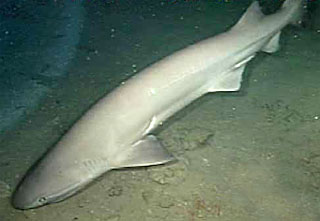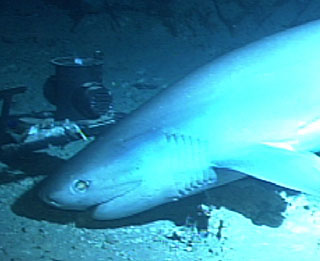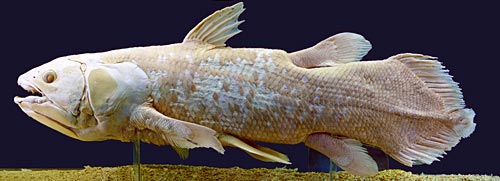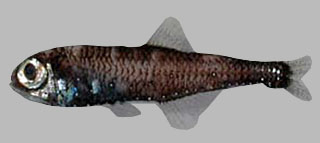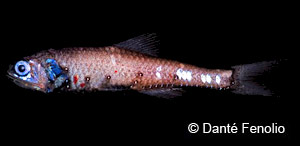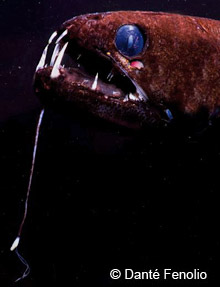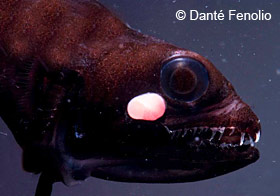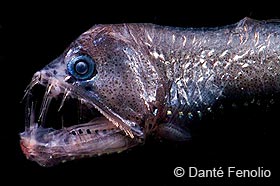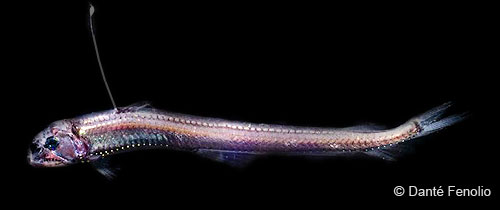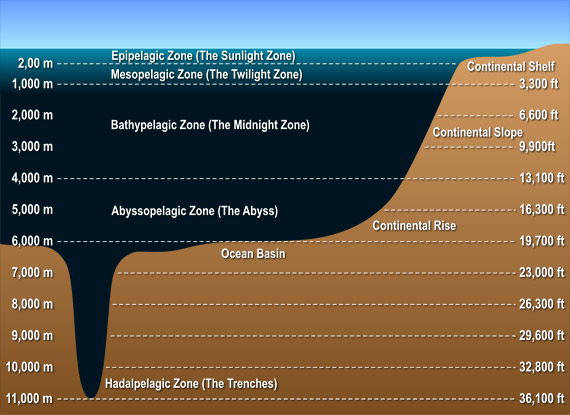Sperm Whale sources sited http://www.seasky.org/deepsea/ocean-layers.html http://www.seasky.org/deep-sea/deep-sea-menu.html supreme potato dude Sean
(Physeter macrocephalus)
 The sperm whale, known to science as Physeter macrocephalus, is the largest of the toothed whales, which includes other members such as the dolphin and killer whale. These whales get their name from the oily fat, known as spermaceti, which is contained in their large heads. It is because of this substance and the oil from the whale's blubber that these majestic animals where viciously hunted by whaling boats. In older times, sperm whales were known as common cachalot, which was an old French word for "tooth". As with all whales, sperm whales are mammals and require air to breathe. They are one of the deepest diving mammals in the world, and are able to stay underwater for up to two hours before coming up for air.
The sperm whale, known to science as Physeter macrocephalus, is the largest of the toothed whales, which includes other members such as the dolphin and killer whale. These whales get their name from the oily fat, known as spermaceti, which is contained in their large heads. It is because of this substance and the oil from the whale's blubber that these majestic animals where viciously hunted by whaling boats. In older times, sperm whales were known as common cachalot, which was an old French word for "tooth". As with all whales, sperm whales are mammals and require air to breathe. They are one of the deepest diving mammals in the world, and are able to stay underwater for up to two hours before coming up for air.
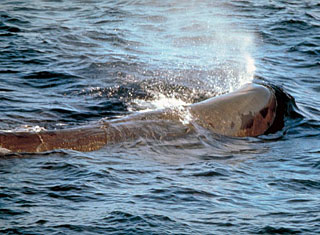
A sperm breaches the surface of the
water to grab a breath of fresh air.
(Clipart.com Image)
The sperm whale can grow to a length of 67 feet (20.5 meters) and weigh over 63 tons (57,000 kilograms). Sperm whales are one of the most sexually dimorphic of all the whale species, meaning that the males and females differ greatly in size and weight. The males are generally 30% to 50% larger than the females. The whale's large head accounts for up to two-thirds of the animal's total length, and it has the largest brain of any animal in the world. Unlike most other whales, which have smooth skin, the skin on the back of the sperm whale is rough and wrinkly. In fact, it has been compared to that of a prune by many whale watchers. The sperm whale does not have a pronounced dorsal fin on its back. Instead, it has a series of ridges, the largest of which resembles a small hump. The color of these whales is usually a uniform gray, although they sometimes look more brownish-gray in sunlight. White albino whales have sometimes been observed in the wild.
Like other toothed whales, sperm whales use echolocation to find their food. They create a series of high-frequency clicks through cavities in their skull. These clicking sounds reflect back off of fish, squid, and other animals, allowing the whale to virtually see in the dark. This skill comes in handy as the sperm whales search the dark ocean depths for food. Their favorite meal is squid, and these whales are one of the only natural enemies of the legendary giant squid and its larger cousin, the colossal squid. While these battles between the world's two largest predators have never been observed directly, much evidence has been found on the bodies of dead whales. The remains of these massive squid have been found in the stomachs of the whales, and scars from the powerful suction cups of the squid's arms have been found on the whales' skin. The whales will dive as deep as 10,000 feet (3,000 meters) in search of the massive squid, although they more typically hunt at about 2,600 feet (800 meters). These deep diving hunting trips can last as long as an hour. It is believed that the hard beaks of the squid in the whales' intestines leads to the production of ambergris, a sweet-smelling substance that was once used to make perfume. Sperm whales consume nearly three percent of their body weight in food each and every day.
Sperm whales are social animals. Females tend to stay in groups of about a dozen individuals along with their young. The males usually leave these schools between the ages of 4 and 21 years to join bachelor schools with males of a similar age. As the males grow older, they tend to stay with smaller groups until they grow old enough to live a solitary life. In spite of their reputation as a fierce hunter, sperm whales have a natural enemy in the form of the killer whale, also known as the orca. Pods of orcas have been known to target groups of females where they try to separate the young whales from their mothers. The female whales attempt to protect their babies by forming a circle with the young calves in the center. They use their teeth and tales as weapons against the invading killer whales. It is believed that only the largest and oldest sperm whales are immune to the attacks of the orca.
In the wild, sperm whales are believed to live about 70 years. Like all whales, they give birth to live young. A single young calf is born after a gestation period of about 14 to 16 months. The calf will suckle on its mother's milk for up to 42 months. Females reach maturity at between 7 and 13 years of age, while males generally do not mature until the age of 18. Male sperm whales do not reach their maximum size until about 50 years of age.
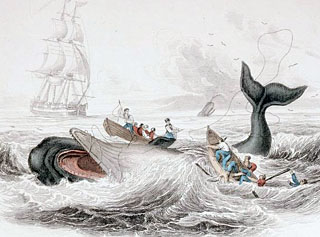
Sperm whales were once aggressively
hunted for their oil and meat.
(Clipart.com Image)
Sperm whales were once the target of the whaling industry and their numbers were decimated by over hunting. They were prized for their oils, which were used to manufacture candles, soaps, cosmetics, lamp oil, and a number of other products. Ambergris, a waxy substance found in the whale's digestive system, was used to make perfume. The whales were also hunted extensively for their meat. During whaling operations over the last three centuries, it is estimated that the global population was reduced from 1.1 million to only 360,000. Today, the sperm whale is protect in most parts of the world. Only Japan and Indonesia still hunt and kill them. They are currently listed as a vulnerable species, and their biggest modern threats are from fishing nets, pollution, and ocean debris.
Sperm whales are found in nearly all of the oceans of the world, from polar waters to the equator. They are found in most marine waters deeper than 3,300 feet (1,000 meters). They are particularly plentiful near continental shelf regions and ocean canyons, where they hunt for deep sea squid at depths of up to 10,000 feet (3,000 meters). Although both sexes can be found in temperate and tropical regions, only the adult males move into the higher latitudes.
Sixgill Shark
(Hexanchus griseus)
 The sixgill shark, or Hexanchus griseus, is a common species of deep water shark. It is also one of the largest sharks that feed on prey other than plankton. This shark gets its name from the fact that is has six gill slits, unlike most other sharks which have only five. It is also known by many other names, such as cow shark and mud shark. This primitive species is one of the few surviving members of the Hexanchidae family. It is related to today's dogfish and Greenland shark, although it is much more closely related to species found only in fossils. Some of the sixgill shark's relatives date back over 200 million years.
The sixgill shark, or Hexanchus griseus, is a common species of deep water shark. It is also one of the largest sharks that feed on prey other than plankton. This shark gets its name from the fact that is has six gill slits, unlike most other sharks which have only five. It is also known by many other names, such as cow shark and mud shark. This primitive species is one of the few surviving members of the Hexanchidae family. It is related to today's dogfish and Greenland shark, although it is much more closely related to species found only in fossils. Some of the sixgill shark's relatives date back over 200 million years.
The sixgill shark has a heavy, powerful body with a round, blunt snout. In fact, it is sometimes referred to as the bluntnose sixgill shark. One of its most distinguishing characteristics is the fact that it has only one dorsal fin, which is located on the back of its body near the tail. Most other sharks have a pronounced dorsal fin on their backs near the center of their bodies. The sixgill ranges in color from tan or brown to gray or even black. It has small, flourescent green eyes with a black pupil. This large shark species can grow to a length of up to 18 feet (5.4 meters). The females are generally larger than the males.
Although sixgill sharks are usually slow and sluggish, their body structure allows them to attain high bursts of speed when chasing and catching their prey. They are carnivorous predators, feeding mostly on cephalopods, crustaceans, fish, and rays, and some marine mammals. These sharks spend most of their time in deep water during the day. At night, they undertake vertical migrations up to shallower waters to feed. During this time, it is not uncommon for them to come in contact with divers, but they are not usually dangerous to humans unless provoked.
Due to the solitary lifestyle of sixgill sharks, very little is known about their reproductive behavior. Many biologists believe that they meet seasonally, moving to shallower waters between May and November to mate. Sixgill sharks are ovoviviparous, meaning that the eggs are carried within the mother's body until they hatch. After hatching, still within the mother's body, the young have been known to eat any unfertilized eggs and even each other. These young sharks, known as pups, are a little more than two feet (about 70 centimeters) in length when they are born. The color of the pups is lighter than that of the adults, allowing them a certain amount of camoflauge to help hide them from predators. There are between 22 and 108 pups born at any given time. Because of these large numbers, it is thought that there is an extremely high mortality rate among the pups and not many survive to maturity. Those that do survive are believed to live about 80 years in the wild.
Sixgill sharks have the widest distribution of all sharks, except for possibly the great white. They are found all over the world in temperate and tropical regions, where they have been known to dive as deep as 6,000 feet (over 1,800 meters). They are more typically found at depths of about 300 feet (90 meters). These sharks have been observed moving into water as shallow as 100 feet (30 meters) during parts of the year in some locations. It is not yet known why they do this. Since they do venture into shall water, fishermen are killing them for sport and food. Because of their low reproductive rate, they can easily be overfished. This has achieved them a near-threatened status on the global list of endangered species. But because we know so little about their populations, many scientists believe they could be in even more danger of extinction.
Coelacanth
(Latimeria chalumnae)
 The strange-looking coelacanth is one of the oldest species of fish in the world. It is considered by many to be an actual living fossil. Known scientifically as Latimeria chalumnae, this fish was thought to have been extinct since the end of the cretaceous period over 65 million years ago. Fossils of the coelacanth have been found that date back over 350 million years. But, against all odds, in 1938, a fisherman actually caught a live coelacanth off the coast of South Africa. A second specimen was captured in 1952 off the coast of the Comoros Islands off theeastern coast of Africa near Madagascar. Needless to say, this caused a sensation throughout the scientific community. Since then, live coelacanths have been sighted and photographed many times in the wild.
The strange-looking coelacanth is one of the oldest species of fish in the world. It is considered by many to be an actual living fossil. Known scientifically as Latimeria chalumnae, this fish was thought to have been extinct since the end of the cretaceous period over 65 million years ago. Fossils of the coelacanth have been found that date back over 350 million years. But, against all odds, in 1938, a fisherman actually caught a live coelacanth off the coast of South Africa. A second specimen was captured in 1952 off the coast of the Comoros Islands off theeastern coast of Africa near Madagascar. Needless to say, this caused a sensation throughout the scientific community. Since then, live coelacanths have been sighted and photographed many times in the wild.
The coelacanth is closely related to the lungfishes and tetrapods, ancient animals that form part of the evolutionary bridge between sea creatures and land dwellers. The long fins of the coelacanth actually contain bones that resemble toes divided into three lobes. Because of this, it is referred to as a lobe-finned fish. These leg-like fins have earned this fish the nickname, "old fourlegs". Another prehistoric feature of this unique fish are its scales. These highly modified scales are known as cosmoid scales, and are only found on extinct fish species. They are woven tight like armor and are rough to the touch. These hard scales help protect the fish from rocks and predators. Coelacanths are large fish, growing to average length of 6.5 feet (2 meters). They can weigh as much as 175 pounds (80 kg). In the wild, they have a deep blue color which is thought to help camoflauge them from predators. The eyes of the coelacanth are extremely sensitive to light. They contain a special adaptation known as a tapetum, which is also found in cats, dogs, and dolphins. It is the tapetum that causes a cat's eyes to glow when exposed to bright light. This highly specialized eye enables the coelacanth to see as much as possible in the lightless environments of the deep sea.
Coelacanth specimen on display at the natural history museum in Vienna, Austria
Ceolacanths are opportunistic feeders, eating just about anything they can find and fit in their mouth. They possess hinges in their skulls that allow them to consume very large prey. Their diet is believed to consist mainly of squid, eels, small sharks, and other animals that are found in their deep sea habitats. They hunt their prey near deep underwater volcanic slopes and can frequently be seen swimming with their heads down. They have even been seen swimming upside down and backwards. Researchers believe that this behavior allows them to use a special organ called a rostral gland to help them locate their prey. Once located, their meal is usually swallowed whole. Since food can be scarce at these great depths, scientists believe that the coelacanth has the ability to slow down its metabolism. This allows the fish to go for long periods of time without eating. This may be part of the reason they have survived so long and outlived their other prehistoric cousins. In their natural habitat, they are believed to live about 60 years.
Coelacanths give birth to live young, known as "pups". There are usually between 5 and 25 pups born at any given time. These young coelacanth pups are fully formed and capable of surviving on their own as soon as they are born. Their gestation time is 13 months, and it is believed that ceolacanths are unable to reproduce until they are 20 years old. Beyond that, very little is known about the reproductive habits of this elusive creature.
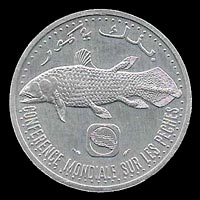
A 5-Franc coin from the
island country of Comoros
(Wikipedia Commons image)
Coelacanths can be found throughout the Indian ocean, from the southwest coast of Africa to Indonesia. They can to go as deep as 2,300 feet (700 meters), but are more commonly found at a depth of 300 - 600 feet (90 - 200 meters). Because of their sensitive eyes, these fish prefer the darkness. They are rarely ever seen during the daytime hours or on nights with a full moon. They prefer cold water because their gills have trouble absorbing oxygen in warm water. In Sodwana Bay, South Africa, coelacanths have been found resting in caves during the day.
In 1989, the coelacanth was declared an endangered species by the international community. Their current world population is believed to be fewer than 500 animals. This means that without protection, this prehistoric animal that has survived for over 350 million years could be wiped out in our lifetime.
Lanternfish
(Symbolophorus barnardi)
 The lanternfish, also known as Symbolophorus barnardi, is a deep-water fish that gets its name from its ability to produce light. The light is given off by tiny organs known as photophores. A chemical reaction inside the photophore gives off light in a chemical process known as bioluminescence. It is the same process used by fireflies and is similar to the chemical reaction inside the green light sticks that children use on halloween. The photophores are located on the fish's head, underside, and tail. It is believed that these light organs are used to attract other small fish on which the lanternfish feeds. They may also be used to signal other lanternfish during mating.
The lanternfish, also known as Symbolophorus barnardi, is a deep-water fish that gets its name from its ability to produce light. The light is given off by tiny organs known as photophores. A chemical reaction inside the photophore gives off light in a chemical process known as bioluminescence. It is the same process used by fireflies and is similar to the chemical reaction inside the green light sticks that children use on halloween. The photophores are located on the fish's head, underside, and tail. It is believed that these light organs are used to attract other small fish on which the lanternfish feeds. They may also be used to signal other lanternfish during mating.
Photo of a lanternfish. Light -producing
photophores are visible as white dots.
(NOAA public domain image)
There are over two hundred different species of lanternfishes in the deep sea. In fact, they are thought to be some the most common deep ocean creatures. Sampling by deep sea trawling indicates that lanternfish make up as much as 65% of the deep sea biomass. They are among the most most widely distributed and diverse of all vertebrate species and it is believed that they play an important role as prey for larger organisms. In southern oceans, they provide an important food source for squid and penguins. Lanternfish typically grow to a length of up to 6 inches (15 centimeters), although some species can range in size from 1 to 12 inches (2 to 30 centimeters) in length. They have a very slender, compressed body covered with silvery scales and relatively small fins. They also have a large, round head and large eyes. Large eyes are common in deep sea creatures as they help to collect as much light as possible in the eternally dark waters. The body of the lanternfish is covered with light-producing photophores. The arrangement of these lights varies by species. In some species, it also varies by gender. There is only one species of lanternfish that is not capable of producing light.
Lanternfish are known for their diel vertical migrations. They spend the day in the deep ocean but come close to the surface at night in search of food. They do this to follow the similar migrations of plankton, which serve as their primary food source. It is thought that these migrations may also serve to help the lanternfish avoid predation. By returning to the deep sea during the day, they avoid many of the large predators in the shallower seas. At shallower depths, lanternfish provide an important food source to a number of organisms including whales, dolphins, tuna, sharks, seals, squid, and sea birds.
Lanternfish are known as non-guarding pelagic spawners. This means that the females release their eggs into the water column as a group where they are then fertilized externally by the males. Depending on the species, between 100 and 2,000 eggs are released by each fish. Spawning is believed to occur year around in most species. Once the eggs hatch, the young larvae have a small number of photophores for producing light. They are left to fend for themselves until they reach maturity. Lanternfish are so plentiful it is thought that their larvae may account for nearly 50% of all fish larvae found in the ocean.
Lanternfish are found in all of the world oceans at depths ranging from 1,200 to 3,000 feet (about 360 to 900 meters). Most species prefer to remain close to the coast where they are commonly found in large schools near the continental slopes. Different species have been known to separate themselves according to depth. They will form dense layers according to species. It is believed that this behavior is intended to reduce competition between species. These layers contain so many fish and are so dense that they can actually be visible on sonar. They can reflect the sonar beams and give the impression of a false ocean bottom known as a deep-scattering layer. This phenomenon confused oceanographers for many years until the source was finally identified.
Deep Sea Dragonfish
(Grammatostomias flagellibarba)
 The deep sea dragonfish, sometimes known as the scaleless dragonfish, is a ferocious predator that inhabits the deep oceans of the world. Known scientifically as Grammatostomias flagellibarba, it has extremely large teeth compared to its body size. In spite of its gruesome appearance, its is a small fish, measuring only about 6 inches (about 15 centimeters) in length. There are several different species of dragonfish. All are very similar in appearance.
The deep sea dragonfish, sometimes known as the scaleless dragonfish, is a ferocious predator that inhabits the deep oceans of the world. Known scientifically as Grammatostomias flagellibarba, it has extremely large teeth compared to its body size. In spite of its gruesome appearance, its is a small fish, measuring only about 6 inches (about 15 centimeters) in length. There are several different species of dragonfish. All are very similar in appearance.
The deep sea dragonfish is one of the many species of deep sea fish that can produce its own light through a chemical process known asbioluminescence. The light is produced by a special organ known as a photophore. It is believed that the fish can use these flashing lights in the dark waters to attract prey and even to signal potential mates. The dragonfish has a large head and mouth equipped with many sharp, fang-like teeth. It also has a long protrusion known as a barbel attached to its chin. This barbel is tipped with a light-producing photophore. The dragonfish also has photophores along the sides of its body. These light organs may be used to signal other dragonfish during mating. They may also serve to attract and disorient prey fishes from deep below.
The dragonfish can use its light-producing barbel like a fishing lure. By flashing it on and off and waving it back and forth, it is thought that the dragonfish can attract the attention of its potential meal. Once an unsuspecting fish gets too close, it is snapped up in the dragonfish's powerful jaws. The large teeth of the dragonfish help it to grab its prey as it hunts in the dark waters of the deep sea. It will feed on small fish and crustaceans as well as anything else it can find. Since many of their prey also produce light themselves, the dragonfish has evolved special method of remaining hidden from predators after its meal. The walls of its stomach are black to keep the lights concealed while its meal is digested.
Dragonfish closeup showing light-
producing photophore below its eye
(Image courtesy of Danté Fenolio)
Because they live in extremely deep waters, very little is known about the mating habits of the dragonfish. It is believed that they are external spawners, meaning that the female releases eggs into the water to be fertilized by the male. The eggs then float to the surface where they remain until hatching. Once the eggs hatch, the tiny larvae are left to fend for themselves until they can reach maturity. Once mature, they return to the deep ocean to spend the rest of their lives. Not much is known about the life span of the dragonfish.
The deep sea dragonfish lives in deep ocean waters at depths of up to 5,000 feet (1,500 meters). Although dragonfish species are found in most oceans the world, the deep sea dragonfish is limited mainly to the North and Western Atlantic Ocean and the Gulf of Mexico.
Viperfish
(Chauliodus sloani)
 The viperfish is one of the most unusual-looking fish in the deep sea. It is also one of the most popular and well-known species. Known scientifically as Chauliodus sloani, it is one of the fiercest predators of the deep. This fish can be easily recognized by its large mouth and sharp, fang-like teeth. In fact, these fangs are so large that they will not fit inside the mouth. Instead, they curve back very close to the fish's eyes. The viperfish is thought to use these sharp teeth to impale its victims by swimming at them at high speeds. The first vertebra, right behind the head, is actually designed to act as a shock absorber. This fearsome looking creature has a long dorsal spine that is tipped with a photophore, a light-producing organ. The viperfish uses this light organ to attract its prey through a process known as bioluminescence. By flashing the light on and off, it can be used like a fishing lure to attract smaller fish.
The viperfish is one of the most unusual-looking fish in the deep sea. It is also one of the most popular and well-known species. Known scientifically as Chauliodus sloani, it is one of the fiercest predators of the deep. This fish can be easily recognized by its large mouth and sharp, fang-like teeth. In fact, these fangs are so large that they will not fit inside the mouth. Instead, they curve back very close to the fish's eyes. The viperfish is thought to use these sharp teeth to impale its victims by swimming at them at high speeds. The first vertebra, right behind the head, is actually designed to act as a shock absorber. This fearsome looking creature has a long dorsal spine that is tipped with a photophore, a light-producing organ. The viperfish uses this light organ to attract its prey through a process known as bioluminescence. By flashing the light on and off, it can be used like a fishing lure to attract smaller fish.
In spite of its ferocious appearance, the viperfish is a relatively small animal, growing to about 11 or 12 inches (30 centimeters) in length. It is usually dark silvery blue in color, but its coloration can vary from green to silver or black. Although the main light organ is located at the end of the elongated dorsal fin ray, there are also several photophores located all along the side of the fish. These may help to camouflage the fish from predators lurking below. These lights make its bottom side appear to blend in with the extremely faint light filtering down from above. They may also serve to attract prey and communicate with potential mates or rivals.
The unusually large teeth of the viperfish help it to grab hold of its prey at it hunts in the darkness. Viperfish have been observed hanging motionless in the water, waving their lures over their heads like a fishing pole to attract their meals. They have a hinged skull, which can be rotated up for swallowing unusually large prey. They also have very large stomachs that allow them to stock up on food whenever it is plentiful. Viperfish feed primarily on crustaceans and small fish. Like many deep-sea creatures, they are known to migrate vertically throughout the day. During daytime hours they are usually found in deep water down to 5,000 feet (1,500 meters). At night they travel up to shallower waters at depths of less than 2,000 feet (600 meters) where food is more plentiful. Viperfish have a very low basal metabolic rate, which means they can go for days without food. This adaptation is likely a result of the scarce nature of food in the deep sea. Viperfish are known to be preyed upon by sharks and some species of dolphin.
Image of a viperfish; notice the light organ on top of the extended dorsal fin ray
(Image courtesy of Danté Fenolio)
Because of the extreme depths at which they are found, very little is known about the reproductive habits of the viperfish. It is believed that they are external spawners, meaning that the female releases eggs into the water to be fertilized. Spawning probably occurs throughout the year, although the numbers of young larvae have been discovered to be highest between January and March. These larvae are approximately six millimeters long (approximately a quarter of an inch) when they hatch. They are left to fend for themselves until they can reach maturity. Not much is known about the life span of the viperfish, but most researchers think they live between 15 and 30 years. In captivity, they rarely live longer than a few hours.
Viperfish are found in tropical and temperate waters throughout the world at depths of up to 9,000 feet (2,800 meters). They are rarely seen by humans, although specimens do sometimes show up in the catches of deep water trawlers. These occasional catches provide scientists with unique opportunities to study this elusive animal. Because they live in such deep waters, it is believed that human activity has very little impact on their populations.

